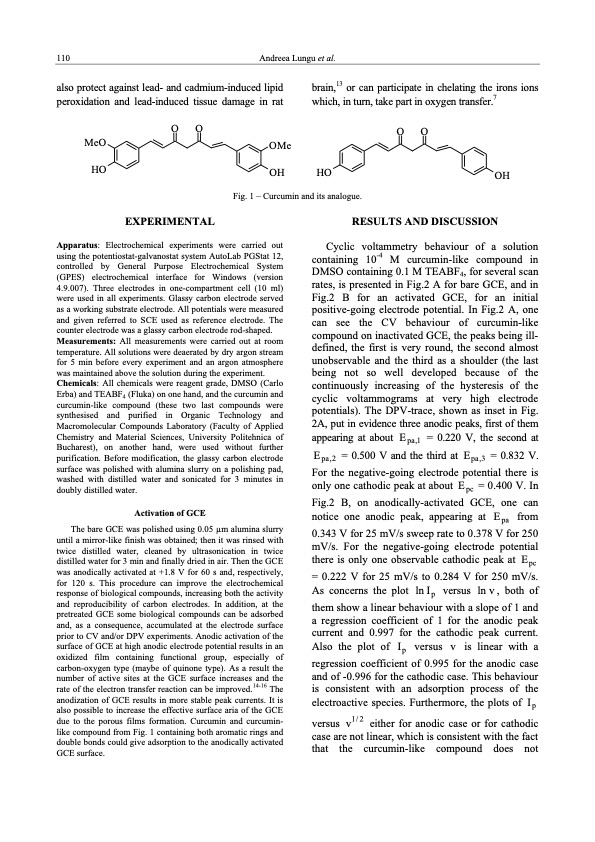
PDF Publication Title:
Text from PDF Page: 002
110 Andreea Lungu et al. also protect against lead- and cadmium-induced lipid peroxidation and lead-induced tissue damage in rat brain,13 or can participate in chelating the irons ions which, in turn, take part in oxygen transfer.7 OO EXPERIMENTAL Apparatus: Electrochemical experiments were carried out using the potentiostat-galvanostat system AutoLab PGStat 12, controlled by General Purpose Electrochemical System (GPES) electrochemical interface for Windows (version 4.9.007). Three electrodes in one-compartment cell (10 ml) were used in all experiments. Glassy carbon electrode served as a working substrate electrode. All potentials were measured and given referred to SCE used as reference electrode. The counter electrode was a glassy carbon electrode rod-shaped. Measurements: All measurements were carried out at room temperature. All solutions were deaerated by dry argon stream for 5 min before every experiment and an argon atmosphere was maintained above the solution during the experiment. Chemicals: All chemicals were reagent grade, DMSO (Carlo Erba) and TEABF4 (Fluka) on one hand, and the curcumin and curcumin-like compound (these two last compounds were synthesised and purified in Organic Technology and Macromolecular Compounds Laboratory (Faculty of Applied Chemistry and Material Sciences, University Politehnica of Bucharest), on another hand, were used without further purification. Before modification, the glassy carbon electrode surface was polished with alumina slurry on a polishing pad, washed with distilled water and sonicated for 3 minutes in doubly distilled water. Activation of GCE The bare GCE was polished using 0.05 μm alumina slurry until a mirror-like finish was obtained; then it was rinsed with twice distilled water, cleaned by ultrasonication in twice distilled water for 3 min and finally dried in air. Then the GCE was anodically activated at +1.8 V for 60 s and, respectively, for 120 s. This procedure can improve the electrochemical response of biological compounds, increasing both the activity and reproducibility of carbon electrodes. In addition, at the pretreated GCE some biological compounds can be adsorbed and, as a consequence, accumulated at the electrode surface prior to CV and/or DPV experiments. Anodic activation of the surface of GCE at high anodic electrode potential results in an oxidized film containing functional group, especially of carbon-oxygen type (maybe of quinone type). As a result the number of active sites at the GCE surface increases and the rate of the electron transfer reaction can be improved.14-16 The anodization of GCE results in more stable peak currents. It is also possible to increase the effective surface aria of the GCE due to the porous films formation. Curcumin and curcumin- like compound from Fig. 1 containing both aromatic rings and double bonds could give adsorption to the anodically activated GCE surface. OO MeO HO OMe HO Fig. 1 – Curcumin and its analogue. OH OH RESULTS AND DISCUSSION Cyclic voltammetry behaviour of a solution containing 10-4 M curcumin-like compound in DMSO containing 0.1 M TEABF4, for several scan rates, is presented in Fig.2 A for bare GCE, and in Fig.2 B for an activated GCE, for an initial positive-going electrode potential. In Fig.2 A, one can see the CV behaviour of curcumin-like compound on inactivated GCE, the peaks being ill- defined, the first is very round, the second almost unobservable and the third as a shoulder (the last being not so well developed because of the continuously increasing of the hysteresis of the cyclic voltammograms at very high electrode potentials). The DPV-trace, shown as inset in Fig. 2A, put in evidence three anodic peaks, first of them appearing at about E pa ,1 = 0.220 V, the second at E =0.500Vandthethirdat E pa,2 pa,3 For the negative-going electrode potential there is only one cathodic peak at about E = 0.400 V. In pc Fig.2 B, on anodically-activated GCE, one can notice one anodic peak, appearing at Epa from 0.343 V for 25 mV/s sweep rate to 0.378 V for 250 mV/s. For the negative-going electrode potential there is only one observable cathodic peak at Epc = 0.222 V for 25 mV/s to 0.284 V for 250 mV/s. As concerns the plot ln I versus ln v , both of p them show a linear behaviour with a slope of 1 and a regression coefficient of 1 for the anodic peak current and 0.997 for the cathodic peak current. Also the plot of Ip versus v is linear with a regression coefficient of 0.995 for the anodic case and of -0.996 for the cathodic case. This behaviour is consistent with an adsorption process of the electroactive species. Furthermore, the plots of Ip versus v1/2 either for anodic case or for cathodic case are not linear, which is consistent with the fact that the curcumin-like compound does not =0.832V.PDF Image | ELECTROCHEMICAL STUDY OF CURCUMIN on carbon Electrode

PDF Search Title:
ELECTROCHEMICAL STUDY OF CURCUMIN on carbon ElectrodeOriginal File Name Searched:
electrochemical-curcumin.pdfDIY PDF Search: Google It | Yahoo | Bing
CO2 Organic Rankine Cycle Experimenter Platform The supercritical CO2 phase change system is both a heat pump and organic rankine cycle which can be used for those purposes and as a supercritical extractor for advanced subcritical and supercritical extraction technology. Uses include producing nanoparticles, precious metal CO2 extraction, lithium battery recycling, and other applications... More Info
Heat Pumps CO2 ORC Heat Pump System Platform More Info
| CONTACT TEL: 608-238-6001 Email: greg@infinityturbine.com | RSS | AMP |